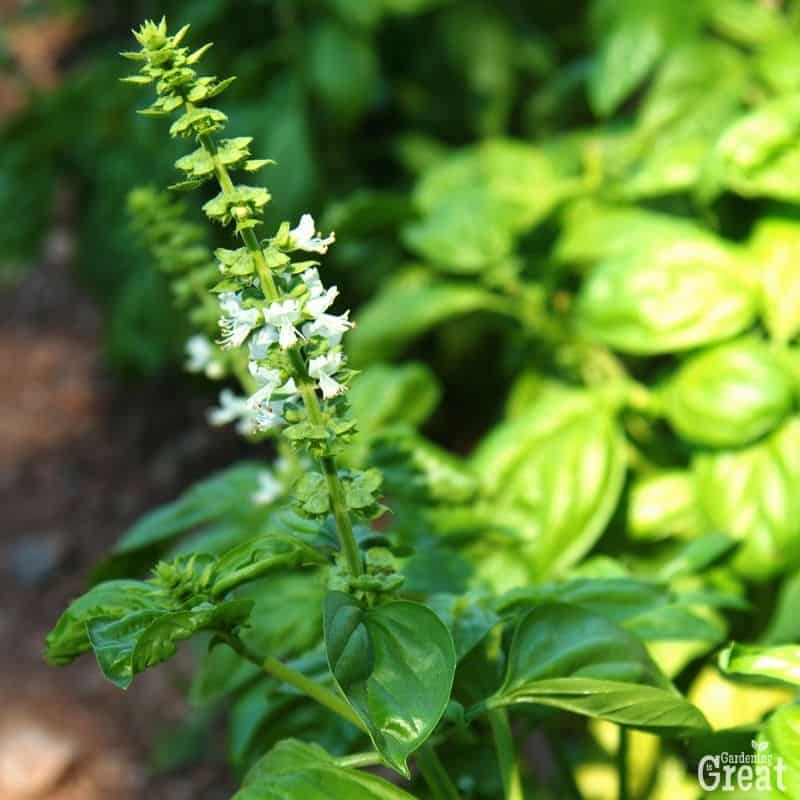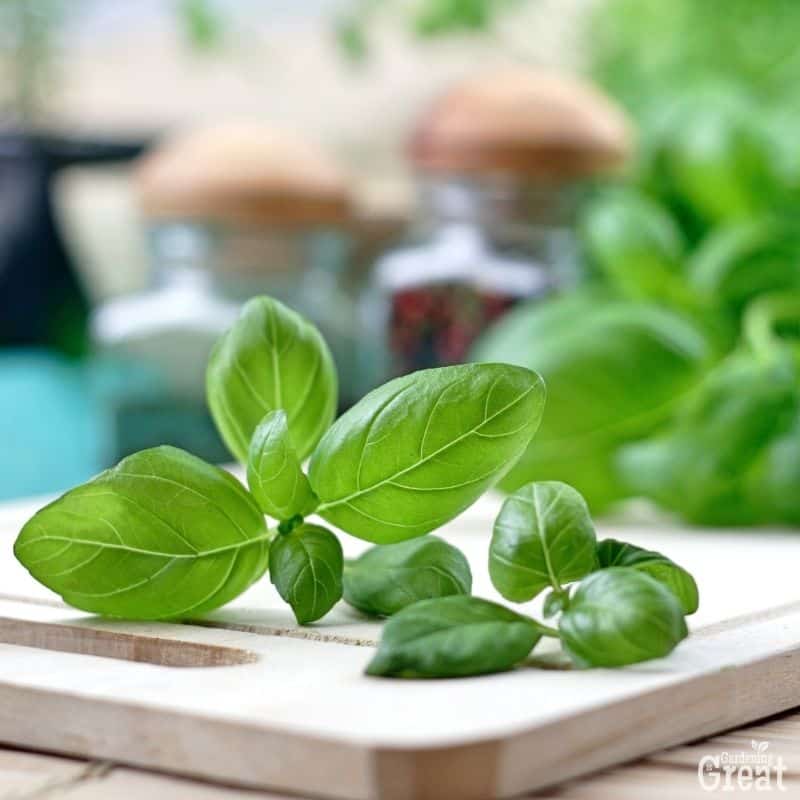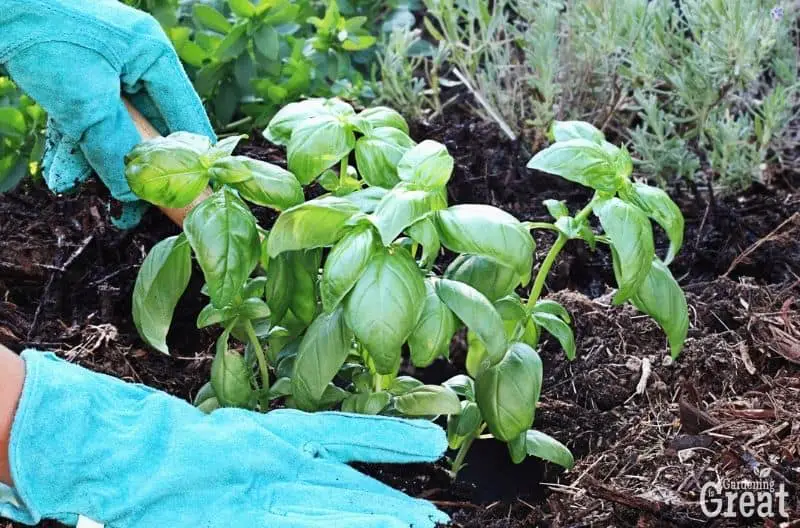How to Plant, Grow, and Harvest Basil
Basil is a great herb for growing at home in your garden, even for beginning gardeners. Growing basil has a ton of uses – from making pesto to adding amazing flavor to Italian dishes.
Growing basil is super easy, and it keeps on producing all season long! Learn how to grow basil so you too can harvest tons of basil.

This post contains affiliate links that earn me a commission at no additional cost to you.
How to Grow Basil
Basil is not a complicated herb. There are only a few basic requirements making it a good choice for beginner gardeners.
Basil is usually started from seed before the season starts. You can start basil indoors up to 6 weeks before the last frost. to give it a head start.
The weather should be a constant 70 degrees during the day and the risk of frost needs to have passed before you move your basil plants to your garden.
Basil makes a great addition to herb gardens, flower beds, and even growing alongside your vegetables with companion planting.
1500 Large Leaf Italian Sweet Basil Seeds
Propagation
Basil propagation from cuttings is quite simple. Propagating basil is one way to produce more viable plants faster for sharing or selling.
Take a 4-inch basil cutting right below a leaf node. Remove the leaves off the basil cutting about 2 inches from the end. Make sure that the basil cutting you are using does not yet have flowers on it.
You can then place your basil cutting in a glass of water on a windowsill where it can get good sunlight. Use a clear glass so you can watch your basil grow roots.
Change the water every few days until you see root growth, then leave your basil until it has grown roots about 2 inches or so long.
You may need to wait between two and four weeks for this to happen. If the roots on your basil cutting are 2 inches long or longer, you can plant it in a pot indoors or you can plant the cuttings directly into the garden once the roots are big enough.
Soil Requirements
Before planting your basil till plenty of organic matter and fresh compost into your soil to help improve it.
This will allow your basil plants to grow well in the beginning and help you avoid using fertilizers later in the growing process which would cause fast growth but with a reduced flavor of your basil.
If you wish to fertilize your basil you can do a light liquid compost tea after 3 to 4 weeks.
Sunlight
Bail thrives in full sun. It loves warm temperatures but like many leafy greens for those living in the southern zones, you should provide shade during the worst of the afternoon heat to help your basil plants survive the heat. Shade cloth or planting on the north side of your home works well for this.
Water Requirements
Basil likes to stay moist and requires about 1 inch of water every week. Water deeply at least once a week to keep roots growing deep and the soil moist.
The best time of day to water basil is early in the morning. Mulching your basil plants can help trap moisture and keep them from drying out between waterings.
Pruning
To help encourage your basil to grow more springs, pinch it back after your plants have grown two sets of true leaves. This will encourage the plant to bush out more leaving you with a larger harvest.
Frequent harvesting during the growing season can help with this as well.
Companion Planting
Basil grows well with vegetables and other popular plants. Basil is an amazing and flavor-enhancing partner for tomatoes. They blend together well both in the kitchen and in the garden.
Basil also grows well alongside other fragrant herbs in the mint family, peppers, and lettuce.
Flowering/Bolting
When basil plants bloom, it is called “bolting”. The flowers are pretty and bees love them.
However, for the best flavor of your basil, you want to avoid the plant going to seed. This means you should harvest before the temperature rises and stays too hot at the peak of summer.

You can extend how long your basil has before it bolts or goes to seed by providing shade in the hottest part of the day and keeping the soil moist with regular watering and a thick layer of mulch.
Pinch off any flower stems before they bloom to help with keeping your basil plant’s flavor longer.
Harvesting Your Basil
Basil can be harvested in small pieces all season long.
To ensure your basil will grow and produce more, be sure to do this frequently. When you are ready to harvest, do so in the early morning when the leaves are hydrated and have a nice strong flavor.
For harvesting basil, pinch off bits with your fingers or use clean, dry sheers. To prevent the spread of disease, sterilize your garden shears before using them.
It is a good idea to harvest leaves from the bottom of the stem allowing the plants to continue growing. After the growing season is over, all of the leaves should be taken off to preserve them.
Basil Uses
Basil is an herb that has so many different uses in the kitchen. From pesto to soups, there are numerous ways you can use basil for your meal prep this week.

In addition to its culinary uses, fresh basil also offers other benefits like stress relief and aiding with sleep cycles! These are just some of the amazing things you can do with it besides just throwing it on top of pasta sauce!
Basil: Quick Care Guide
| Common Name | Basil |
| Botanical Name | Ocimum basilicum |
| Germination Time | 8-14 days depending on the variety |
| Days to Harvest | Around 75 days depending on the variety |
| Light | Full sun |
| Water | Prefers consistently moist soil |
| Temperature | 70 degrees optimal |
| Soil | A nutrient-rich, well-draining soil |
| Fertilizer | Fresh compost before planting |
| Pests | Aphids, flea beetles, spider mites, whiteflies, Japanese beetles, grasshoppers, slugs, snails |

Basil Growing Questions
In this section, I will answer some of the most frequently asked questions about growing basil.
No. Basil is an annual plant, meaning it will die in the fall and will not grow back again next year.
Basil grown indoors will most likely remain small but it grows well with the right care. Check out our guide on how to grow basil indoors.
Ready to add more herbs to your garden? Why not start with one of these:

